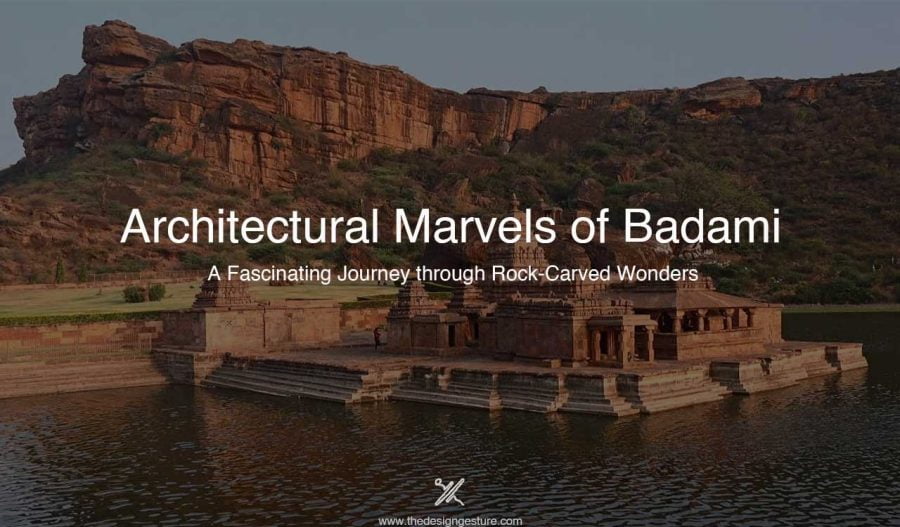Table of Contents
Introduction
Nestled amid rugged sandstone hills and flanked by Agastya Lake, Badami is an archaeological treasure trove that transports visitors back in time to the Chalukyan dynasty’s glorious era. Badami seamlessly blends natural beauty with cultural heritage, offering a captivating destination for history enthusiasts. From 540 until 757, it served as the Badami Chalukyas’ royal capital. It is well-known for its structure temples, including the Bhutanatha Temples, Badami Shivalaya, and Jambulingesvara Temple, and its rock-cut monuments, like the Badami cave temples.
History
The Chalukya dynasty played a pivotal role in shaping the history of Badami. Pulakeshin I, a prominent ruler of the Chalukya dynasty, founded the city of Badami in 540 AD and established it as his capital. Following his reign, his son Kirtivarman I ascended to the throne and played a crucial role in the architectural landscape of Badami. It was during Kirtivarman I’s rule that the magnificent cave temples, which are a hallmark of Badami’s cultural heritage, were constructed.
Kirtivarman I had three sons – Pulkeshin II, Vishnuvardhana, and Buddhavarasa. The legacy of the Chalukya dynasty continued through these successors, each contributing in their way to the prosperity and cultural development of Badami. Under the Badami Chalukyas, the city of Badami became a flourishing regional center for art, particularly in the Malprabha Valley. This era witnessed the rise of distinctive Hindu and Jain temple architecture schools. Badami, along with other nearby sites like Aihole, Pattadakal, and Mahakuta, became a cradle for the development of both Dravida and Nagara styles of temple architecture.
After the Chalukyas, the Pallavas captured Badami in 642 AD. However, their rule was short-lived as Vikramaditya I, the son of Pulakeshin II, reclaimed the city in 654 AD. The city later became part of the Vijayanagar Empire. As history unfolded, Badami experienced the rule of diverse powers, including the Mughals, Adil Shahis, Marathas, and the British. The layers of influence from various dynasties have contributed to Badami’s unique identity.
Badami Cave Temples
The Badami Caves stand as a testament to the virtuosity of ancient Indian rock-cut architecture. Under the Chalukya dynasty’s sponsorship, these caverns date to the sixth and seventh centuries and exhibit a harmonious blend of artistic grace and religious holiness. Sleekly etched into the ochre-hued sandstone, each cave reveals a story of heavenly devotion that is characteristic of both Dravidian and Nagara architectural traditions.
Cave 1
The quartet of cave temples, situated approximately one kilometer from Badami Fort, represents an architectural marvel meticulously carved out of the surrounding hill. Cave 1, the earliest and grandest, houses an imposing 18-armed Nataraja, a celestial dance form of Lord Shiva, along with intricate depictions of various Hindu deities.
Cave 1 at Badami, dedicated to Shaivism, unfolds as a repository of intricate carvings and divine manifestations etched into the sandstone canvas. The sanctum’s focal points include an awe-inspiring 18-armed depiction of Lord Shiva in a dynamic dance, symbolizing the cosmic rhythm. The narrative within the cave further unfolds with the portrayal of Mahishasura Mardini, illustrating the cosmic battle between the goddess Durga and the buffalo demon Mahishasura.
Cave 2
While slightly smaller in scale compared to its counterpart, Cave 2 shares a similar floor plan but devotes itself predominantly to the worship of Vishnu. Ascending 64 steps from the first cave, visitors are welcomed by a grand entrance, a verandah adorned with four square pillars, each intricately carved from the monolithic stone face. The pillars themselves are a canvas of decorative carvings, featuring a frieze of ganas, and mythical dwarfs, each displaying a range of expressive facial features.
The ceiling of Cave 2 serves as a celestial tapestry adorned with various divine figures. The iconic imagery includes Anantasayana, the eternal reclining form of Lord Vishnu, exuding a sense of cosmic serenity. Completing the celestial ensemble, the carvings extend to include the Ashtadikpalas, the guardians of the eight cardinal directions in Hindu cosmology. Each panel within Cave 2 contributes to the spiritual narrative, showcasing the artistic brilliance and religious reverence that characterize the cave temples of Badami.
Cave 3
Cave 3 at Badami stands as a seminal milestone in the Deccan region’s religious and architectural history, being recognized as the earliest dated Hindu temple. Dedicated to Vishnu, this cavernous sanctuary unfolds as the largest cave within the complex. Vaishnavite themes take center stage in the artistic ensemble of Cave 3, with its friezes and sculptures providing a rich tapestry of Vishnu-centric symbolism. However, the cave transcends singular devotion, embracing a broader spiritual spectrum.
Adding another layer of artistic splendor, Cave 3 at Badami unveils the enigma of fresco paintings on its ceiling, presenting some of the earliest surviving instances of this intricate art form in Indian history. Among the remnants of these captivating frescoes, the divine presence of Brahma graces the canvas, seated on the celestial vehicle, Hamsa vahana. Another vivid portrayal depicts the sacred union of Shiva and Parvati, a divine matrimonial ceremony witnessed by an array of Hindu deities.
Cave 4
Cave 4, situated immediately to the east of Cave 3, unfolds as a sacred testament to Jainism. This compact cave, the smallest among the four, lies about 10 feet lower than its counterparts. It stands as a poignant symbol of religious diversity within the Badami Caves complex, dedicated to the revered figures of Tirthankaras in Jainism. Constructed in the later part of the 7th century and potentially evolving further in the 8th century, Cave 4 bears the marks of sponsorship by Hindu kings.
To reach this sacred sanctuary, visitors must embark on a steep climb up steps skillfully cut into a crevice between Cave II and III. As one ascends, the ascent culminates in the southern part of the Badami Fort, unveiling historical layers that include an old gun placed by the mighty Tippu Sultan, adding a touch of historical significance to the sacred journey through the caves.
Badami Fort
The fort’s construction began around 543 AD. Pulakeshi, the King of the Chalukyans, constructed the old fort. Perched atop a rugged hill in the town of Badami. The Badami Fort stands as a testimony to the region’s rich historical and architectural legacy. It became a strategic stronghold and the capital under Pulakeshin II. The fort encompasses several structural marvels, including temples and reservoirs.
The fort’s architectural brilliance is a spectacle of thoughtful planning and strategic foresight. From expansive granaries to imposing watchtowers and ingeniously crafted underground chambers, each element stands as a testament to the meticulous effort invested in their creation. Amidst the fort’s formidable structures, a colossal dust-sieved cannon stands as a silent witness to the countless battles and challenges the fort has faced. Its presence underscores the fort’s historical significance, symbolizing an era of warfare and relentless efforts to safeguard the stronghold.
Mallikarjuna Group of Temples
Lord Shiva’s temple complex, the Mallikarjuna Group of Temple, is located 1.5 km from Badami Bus Station. Just before Boothanatha Temple, in a fenced area, are these temples. The temples are carved into the rugged sandstone hills that surround the Agastya Lake, creating a spectacular visual ensemble. The temple’s outside walls are made entirely of uncarved rock. The inner sanctum’s tower was constructed in the traditional Rashtrakuta architectural style. Most of the interior pillars and walls are simple.
Agastya Lake
The lake, named after the revered sage Agastya, embodies a sense of timeless calmness. It is surrounded by the architectural marvels of Badami. The rippling waters of Agastya Lake catch the warm, golden glow, reflecting the celestial canvas above. The surrounding rock hills, like silent spectators, cast elongated shadows, creating a poetic interplay of light and shadow. Local lore weaves tales around the healing properties of Agastya Lake, believed to date back to the 5th century.
Though the water is no longer designated for swimming, its divine essence draws pilgrims seeking spiritual cleansing. Before entering the nearby temples, many make it a ritual to take a dip in the holy waters of Pushkarini or Agastya, believing in the purifying powers of this sacred reservoir. The calm waters of Agastya Lake seem to hold the secrets of centuries, sharing them generously with those who pause to witness the celestial drama unfold.
Archaeological Museum
The museum’s galleries serve as time capsules, preserving remnants from the glorious eras that shaped Badami’s destiny. These stone marvels, once integral parts of temples and structures, now find a sanctuary within the museum walls. The inscriptions, etched in ancient scripts, whisper tales of bygone rulers and their conquests. A stroll through the museum offers a glimpse into the diverse cultural influences that converged in Badami.
Each exhibit invites contemplation, inviting visitors to connect with the lives, beliefs, and artistic expressions of those who once called Badami home. The entrance, adorned by a statue of Nandi, welcomes visitors to a realm where antiquity comes alive. With four galleries, including two open galleries, the museum unfolds its narrative through a carefully curated collection that spans centuries. The inscriptions, some dating back to the 6th century, offer a linguistic bridge to the Chalukyan era, narrating tales of valor, conquests, and religious beliefs.
Bhutanatha Group of Temples
Perched majestically on the banks of the serene Agastya Lake, the Bhutanatha temples create a captivating tableau against the backdrop of the dramatic Badami landscape. The group comprises two main temples, complemented by smaller shrines that collectively weave a narrative of devotion and artistic brilliance. The sanctum of this temple houses a Shivalinga, inviting devotees to partake in rituals and prayers in a space that resonates with spiritual energy.
Adjacent to its grand counterpart, the smaller temple mirrors the architectural finesse and sculptural mastery of the Chalukyan artisans. The distinctive pyramidal vimana (tower) crowning the sanctum adds a touch of grandeur to the complex, inviting awe and reverence. The Bhutanatha Group of Temples, with their symphony of stone and spirituality, stands as a living testament to the Chalukyan dedication to both art and religion.
Ravana Pahad
In the picturesque town of Badami, where every rock holds tales of antiquity, Ravana Pahad stands as a geological marvel and a canvas for ancient legends. Rising majestically on the northeastern side of Agastya Lake, Ravana Pahad commands attention with its sheer cliffs and imposing presence. The demon king is supposed to have taken refuge in the hill’s deep caverns and cracks during his prolonged periods of concentration. The cave temple inside Ravana Pahad further unfolds as a sanctum sanctorum with a Linga representing Lord Shiva.
The cave temple’s architecture follows the traditional Dravidian style, characteristic of the region. Pilgrims and visitors who ascend Ravana Pahad are not just greeted by a geological marvel but are ushered into a sacred space where myth and spirituality converge. A mandapa embellished with bas-relief sculptures of Lord Vishnu’s incarnations welcomes visitors to the cave shrine, lending a decidedly Vaishnavite flavor to the mostly Shaivite atmosphere of Aihole.




